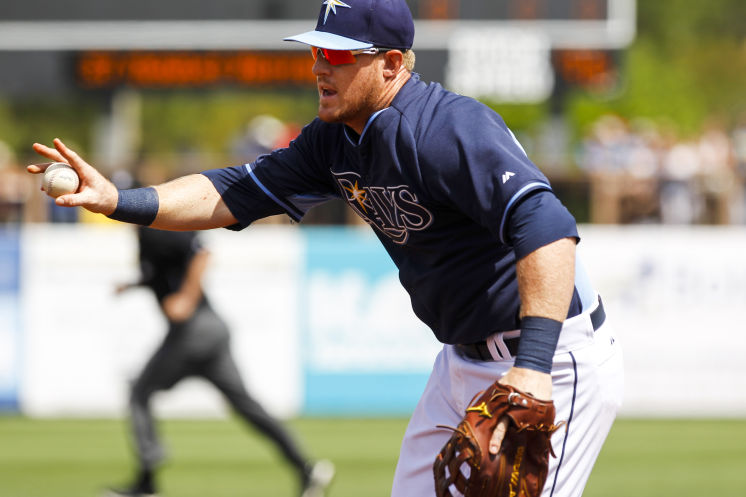
Sound the alarm! Panic! The Tampa Bay Rays fell to a 1-5-1 record on the after dropping both of their split squad games Tuesday afternoon — 4-3 to the Pittsburgh Pirates and 5-1 to the Boston Red Sox. In actuality though, you should probably think twice before you sound the death knell on the season before it even starts. While Spring Training scores and statistics are mostly meaningless, many place too much emphasis on them — especially early on. Instead of summarizing Tuesday afternoon’s split squad action, I thought it a good idea to step back and discuss what we should and shouldn’t be taking away from Spring Training.
- Sample sizes are so small that any meaningful conclusion about a player’s performance isn’t easy to suss out: Everyday starters, and players getting serious roster consideration, will get around 60 at bats during the spring. Why? Among other things, the first statistic to stabilize for hitters is strikeout percentage, and it takes at least 60 plate appearances to do so. Ultimately hitters aren’t worried about looking the perfect pitch to incur damage, they are trying to get their timing down — anything above and beyond is icing on the cake. Take recent acquisition Asdrubal Cabrera for example. Cabrera slashed .357 BA/.438 OBP/.518 SLG/.956 OPS in Spring Training last season, yet he didn’t come close to that line during the regular season. Another example, Pittsburgh Pirates star outfielder Andrew McCutchen — owner of a career .299 BA/.385 OBP/.498 SLG/.883 OPS/.382 wOBA slash line — didn’t get his first Spring Training hit until Monday, a full week into the Grapefruit League season.
- Conditions for hitting in south Florida are vastly different from The Trop: Forget not, the Rays play in a dome where there is less resistance on the ball in flight, and the wind is not a factor. Compare that with Charlotte Sports Park where a stiff breeze blowing in can turn a home run into a routine fly ball. Take Luke Maile’s ninth inning double in Monday’s game against New York Yankees for example. The wind resistance was enough to keep the ball in the park. While that game took place in Tampa and not Port Charlotte, you catch my drift.
- Pitchers aren’t worried about setting up a hitter to freeze him with a nasty slider, rather they are concerned with staying healthy and building arm strength: Pitchers are focused on getting ready for the season, not getting batters out. It takes many pitchers time to build up their arm strength. Dips in velocity are going to happen, homers are going to happen, and a pitcher might look like crap prior to opening day. Still, a handful of poor performances prior to Opening Day isn’t indicative of his future performance. After all Corey Kluber, the reigning American League Cy Young Award winner, posited a 5.60 ERA in Spring Training last season, and he ended the year as the best pitcher in the AL.
- Pitchers use Spring Training to work on pitches: It was written elsewhere, “The time for trial and error is now. Spending time during the season experimenting with a two-seam fastball or a circle change is not a good idea. That should be reserved for side sessions and bullpens. During Spring Training, however, there is absolutely no negative impact to trying out some changes that could eventually be beneficial. Sometimes pitchers will go out to the mound only throwing fastballs away in order to work on their command over the outer half of the plate. Sometimes a pitcher will only work inside and give up a couple bombs from missing spots.” ‘Nuff said.
- Players are going to make errors, and that’s fine: Cloudless skies turn poppers into doubles. Errors from players playing out of position aren’t going to happen during the regular season. Furthermore, Spring Training is a time for players to prove their worth, many of whom are untested players at the major league level. Instead, watch how a player jumps on the ball. Is he quick? Does he have good range? Does his movements seem fluid or stilted? What about his arm? Pay attention to where a player is stationed.
- Take note of who plays where: Manager Kevin Cash is trying to get Desmond Jennings comfortable in left field, and Kevin Kiermaier in center, so he is giving them a good amount of time in those spots during the spring. Also, watch to see who spends more time at short and second; Asdrubal Cabrera or Nick Franklin.
- Watch for injuries: One week into the Spring Training game action, and the injury bug has already plagued many teams — Tampa Bay included. Hunter Pence (broken arm), Cliff Lee (sore elbow), Josh Reddick and Brandon Guyer (oblique injury), Michael Saunders (knee injury), Drew Smyly (tendinitis), and Marcus Stroman (torn ACL) are among those who may (or will) miss a significant amount of time going into Opening Day.
- The win-loss record at the end of the spring means nothing: Cleveland won the Cactus League last season and Tampa Bay had the best record in the Grapefruit League — Miami was second. A lot of help it did the latter two. Conversely, Kansas City went 12-16, and the Los Angeles Dodgers were 7-11, and both teams went deep into the postseason.
